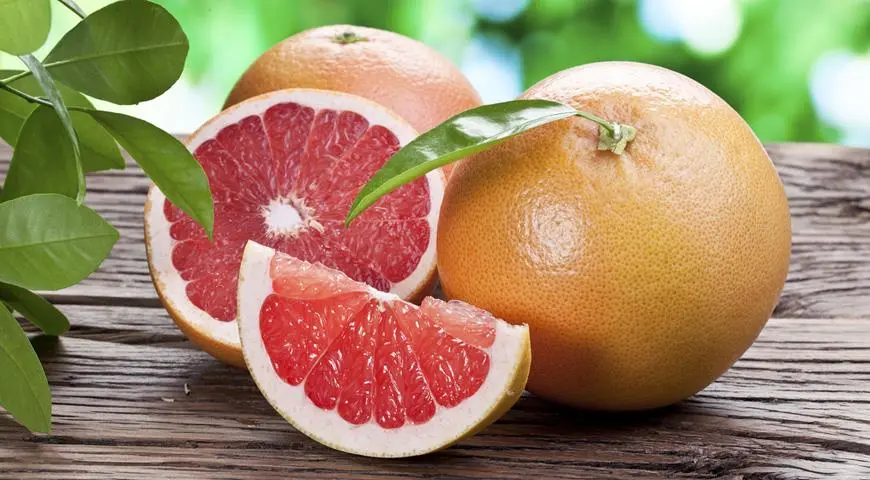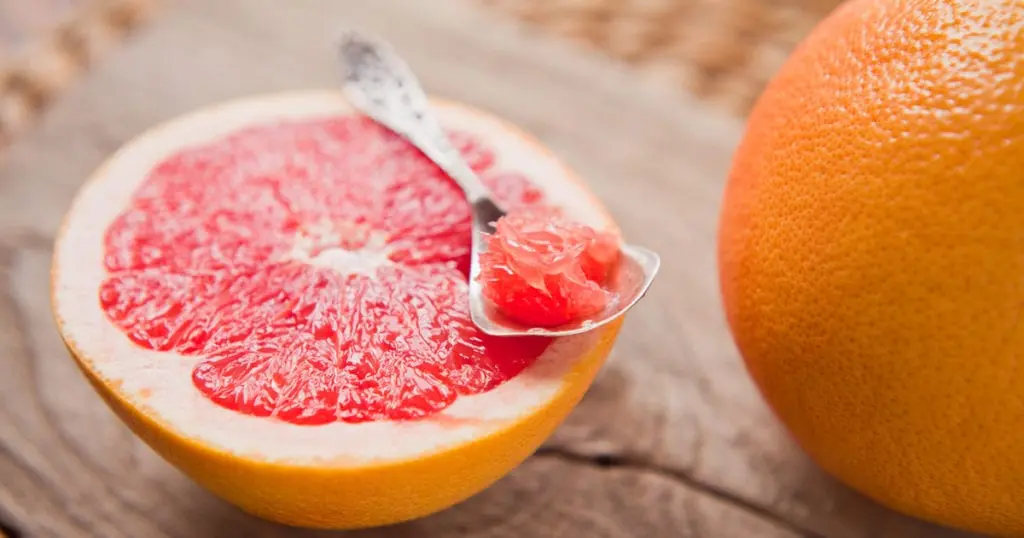Contents
Description
Grapefruit is known for its tonic effect. It gives a boost of vivacity, and also helps to reduce excess weight.
Grapefruit history
Grapefruit is a citrus that grows in the subtropics on an evergreen tree. The fruit is similar to an orange, but larger and redder. It is also called “grape fruit” because the fruit grows in bunches.
It is believed that grapefruit originated in India as a hybrid of pomelo and orange. In the 20th century, this fruit took one of the leading places in the world market. In 1911, the fruit came to Russia.
On February 2, countries that grow grapefruit in large volumes for export celebrate the harvest festival.
Composition and calorie content

- Caloric content 35 kcal
- Proteins 0.7 g
- Fat 0.2 g
- Carbohydrates 6.5 g
- Dietary fiber 1.8 g
- Water 89 g
Grapefruit is rich in vitamins and minerals such as: vitamin C – 50%, silicon – 133.3%
The benefits of grapefruit
Grapefruit is a very “vitamin” fruit: it contains vitamins A, PP, C, D and B vitamins, as well as minerals: potassium, magnesium, calcium, phosphorus and others. The pulp contains fiber, and the peel contains essential oils.
Grapefruit is mentioned in many diets. It helps to reduce weight due to the content of substances that speed up the metabolism, which allows you to burn excess calories faster.

The pulp of the fruit contains substances that break down cholesterol and lower blood sugar levels. This is useful for people with diabetes, high blood pressure and atherosclerosis.
With low gastric acidity, grapefruit can also help. Thanks to the acid in its composition, digestion improves and the absorption of food is facilitated.
This citrus is a good general tonic. Even just the smell of grapefruit (fragrant essential oils in the peel) can reduce headaches and nervousness. In the autumn – winter period, the use of grapefruit will help avoid vitamin deficiency and support the immune system.
Grapefruit harm
Like any citrus, grapefruit more often than other fruits causes allergic reactions, so it should be introduced into the diet gradually, and not given to children under 3 years old.
With frequent use of grapefruit and the simultaneous administration of drugs, the effect of the latter can be enhanced or, conversely, suppressed. Therefore, it is better to consult a doctor about the compatibility of the drug with this fruit.
Excessive consumption of fresh fruits can aggravate diseases of the stomach and intestines. With increased acidity of gastric juice, as well as hepatitis and nephritis, grapefruit is contraindicated.
The use in medicine

One of the known properties of grapefruit is to aid in weight loss. It flushes out waste and excess water, and speeds up the metabolism, making grapefruit a great addition to any diet.
Grapefruit is recommended for people with weakened immune systems, in the recovery period after illness, with chronic fatigue. This fruit tones, has antioxidant properties, saturates the body with vitamins. Grapefruit helps fight infections as it has antimicrobial and antifungal properties.
The fruit is useful for the elderly and people at risk for heart disease, blood vessels and diabetes mellitus, as it lowers cholesterol and sugar levels and strengthens blood vessels.
In cosmetology, grapefruit essential oil is added to anti-cellulite masks, creams against age spots and rashes. For this, you can use fruit juice, but not on inflamed skin. Also, the oil has a relaxing effect, therefore it is used in aromatherapy.
Taste qualities of grapefruit
The palatability of grapefruit depends on the amount of beta-carotene in it. The brighter the rind of the fruit, the more beta-carotene, the sweeter it will be. In addition, red grapefruits are generally much sweeter than white ones. Don’t be intimidated by brown or green tinged fruits.
How to choose

To choose a ripe grapefruit, you need to pick up the fruit and examine it carefully. Determine the specific gravity (the more the better), smell and color. It is believed that fruits are sweeter the more reddish they are on the outside (rind) and inside (flesh). Yellow, green varieties are usually sour.
When choosing, you should pay attention to the appearance of the fruit. Ripeness is indicated by red spots or a ruddy side on a yellow rind. A fruit that is too soft or shriveled is stuck and may ferment. A good fruit has a strong citrus scent.
You need to store grapefruit in the refrigerator in a film or bag for up to 10 days. Peeled slices deteriorate and dry quickly, so it’s best to eat them right away. Freshly squeezed juice can be kept in the refrigerator for up to two days. Dried zest is stored in a sealed glass container for up to a year.
6 Interesting facts about grapefruit

- The earliest of all grapefruit appeared in Malaysia and Indonesia;
- One of the largest grapefruit varieties is called Chinese Grapefruit or Pomelo. The largest harvests of Pomelo grow during the Chinese Lunar New Year;
- Among the varieties of shades of grapefruit are golden, pink, white and red;
- About 75% of all fruit is juice;
- From one medium grapefruit, you can get about 2/3 cup of juice;
- Peeled fruit can hold up to 98% of vitamin C for a whole week.









